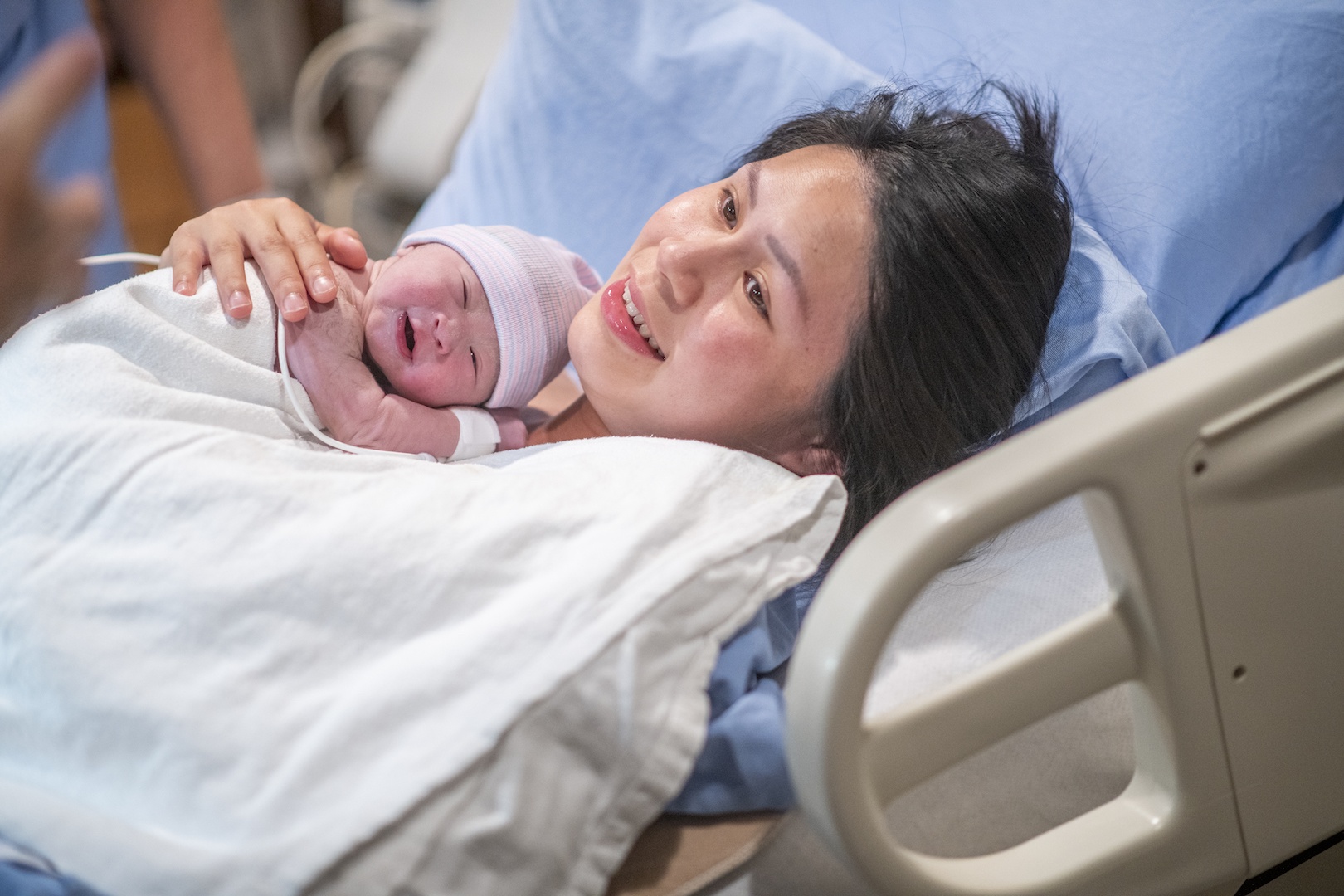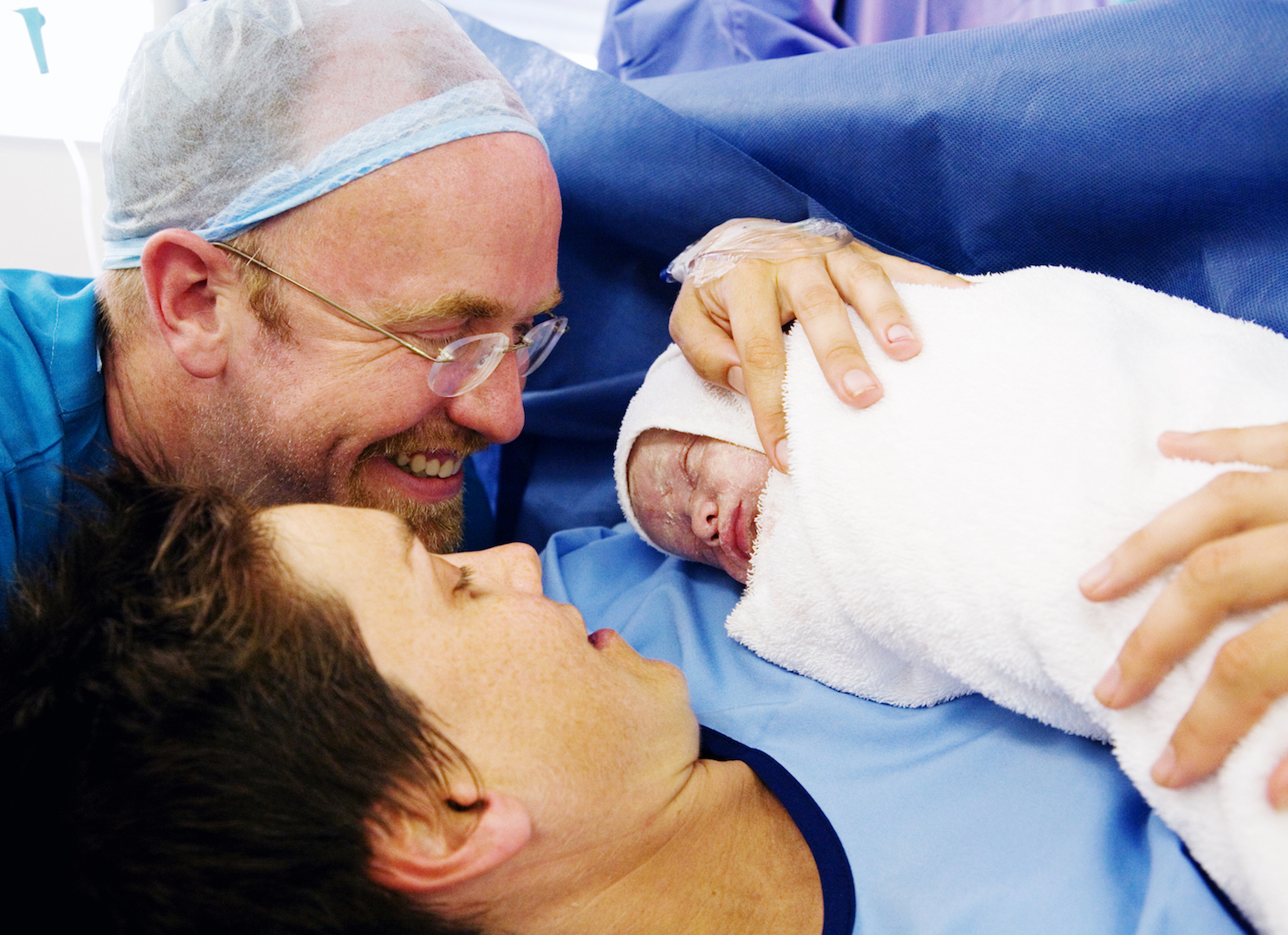Studies of Benefits From a Vaginal Delivery to a Baby
Vaginal birth vs. C-Section: Pros & cons

Babies can enter this world in one of two ways: a vaginal birth or surgical commitment by cesarean section. The ultimate goal of both methods is to ensure that the baby and mother are healthy.
In some cases, a C-section may be expected and thus scheduled in accelerate — for example, in the case of twins or other multiples; a medical condition, such as diabetes or loftier blood force per unit area; an infection that could exist passed along to the baby during birth, such as HIV or genital herpes; or issues with the placenta.
A C-section may likewise be necessary if the babe is very large and the mother has a pocket-size pelvis, or if the infant is not in a heads-down position and efforts to turn the babe into this position before nascency have been unsuccessful.
Related: Signs of labor: half-dozen clues baby is coming before long
Sometimes an obstetrician decides to perform an emergency C-section because the health of the mother, the baby, or both is in jeopardy. This may occur because of a problem during pregnancy or after a woman has gone into labor, such every bit if labor is happening too slowly or if the baby is not getting enough oxygen.
Some C-sections are considered constituent, meaning they are requested before labor. Someone may cull to have a C-section to plan when to evangelize or if they previously had a complicated vaginal delivery. But if someone is eligible for a vaginal commitment, there are not a lot of advantages to having a C-section, said Dr. Allison Bryant, a maternal-fetal medicine specialist at Massachusetts Full general Hospital in Boston.

Although C-sections are generally considered safe and, in some situations, lifesaving, they practise carry risks. The procedure is a major surgery and involves opening upward the abdomen and removing the baby from the uterus. Because first-time C-sections often lead to C-sections in futurity pregnancies, a vaginal birth is by and large the preferred method of delivery for get-go pregnancies. About ii in 3 babies in the The states are born via vaginal delivery, according to the National Center for Health Statistics.
Related: Are you pregnant? 12 early signs of pregnancy
Vaginal birth in people who have previously had a C-department, whether elective or because of an emergency, may be contraindicated depending on the location of their C-section incision and take a chance of uterine rupture in which the uterus bursts open along the one-time cut, according to the Imperial College of Obstetricians and Gynecologists. This type of nascence is known every bit Vaginal Birth After Cesarean (VBAC). However, not all hospitals are not equipped to bargain with VBAC complications and some doctors refuse to oversee them, said Dr. Patricia Santiago-Munoz, a high-risk pregnancy specialist in the Department of Obstetrics and Gynecology at University of Texas Southwestern Medical Eye in Dallas.
Regardless of how they requite nascence, "women should be as informed every bit possible well-nigh their childbirth options so they can have a vocalism in the process, abet for what they want and make the most informed selection," Bryant said. Here is more information nearly the pros and cons of the two birthing methods.
Vaginal delivery: Pros
- Vaginal births typically crave shorter hospital stays and recovery times compared with C-sections. Although country laws vary, the typical length of a hospital stay following a vaginal delivery is 24 to 48 hours, although it could be shorter than the allowable time catamenia permitted in the state, Bryant told Live Science.
- Vaginal births typically avert the risks associated with major surgery, such every bit severe haemorrhage, scarring, infections, reactions to anesthesia and longer-lasting pain. And considering major surgery is not involved, a mother may be able to begin breastfeeding sooner.
- A baby who is delivered vaginally will exist able to have more early on contact with their mother, who can initiate breastfeeding sooner than she could if she had a C-section, Bryant said.
- During a vaginal commitment, muscles involved in the process are more probable to squeeze out the fluid in a newborn's lungs, Bryant said, which is benign because it makes babies less likely to suffer breathing problems at birth.

Vaginal commitment: Cons
- Going through labor and a vaginal delivery is a long process that can exist physically grueling. On boilerplate, first-time mothers spend between four and eight hours in active labor, which is when their cervix is fully dilated and their body wants them to push button, according to maternal- and baby-health system March of Dimes.
- During a vaginal delivery, in that location is a risk that the skin and tissues around the vagina could stretch and tear while the fetus moves through the birth canal. Severe stretching and tearing may require stitches. This stretching and vehement also could cause weakness or injury to pelvic muscles that control urine and bowel functions.
- A 2018 review in the journal PLOS Medicine institute that women who delivered vaginally were more likely to experience urinary incontinence (and leak urine when they cough, sneeze or express joy) and to have pelvic organ prolapse, which is when i or more organs slip into the pelvis, compared with women who delivered via C-section.
- A vaginal delivery may besides cause lingering hurting in the perineum, the area betwixt the vagina and anus.
- If a woman has had a long labor or if the babe is large, the baby may go injured during the vaginal nascence process itself, resulting in a bruised scalp or a fractured collarbone, according to Stanford Children's Health.
C-section: Pros
- A woman may choose to accept a C-department if she has overwhelming feet about a vaginal birth, which may affect her experience of delivery.
- Women who accept C-sections are less likely to suffer from urinary incontinence and pelvic organ prolapse compared with women who deliver vaginally.
- A surgical birth can be scheduled in accelerate, making information technology more convenient and predictable than a vaginal nascence and labor.
- If the baby or mother is in danger, a C-section can be lifesaving.

C-section: Cons
- C-sections typically require longer hospital stays — two to four days, on average, compared with ane to two days for vaginal deliveries. The recovery period is also longer and in that location may be more hurting and discomfort in the abdomen, as the skin and nerves surrounding the surgical scar need fourth dimension to heal, oft at least two months.
- A C-department increases the risk for post-commitment ailments such as pain or infection at the incision site and longer-lasting soreness, co-ordinate to the U.Chiliad.'south National Health Service.
- A C-department involves an increased run a risk of claret loss, Bryant said, every bit the bowel or float tin can be injured during the functioning or a claret clot may form.
- Women who had a C-section are less likely to begin early breastfeeding compared with women who had a vaginal birth, according to a 2012 review published in The American Periodical of Clinical Nutrition.
- Women are three times more likely to die during a cesarean delivery than during a vaginal birth, due generally to blood clots, infections and complications from anesthesia, according to a 2006 study published in the journal Obstetrics & Gynecology. Moreover, a 2017 review based in Brazil found that women were more likely to die during a C-section or develop an infection than during a vaginal commitment, although they were less probable to bleed out.
- Once a woman has had a C-section, she is more likely to have a C-section for future deliveries, Bryant said. There may also be a greater risk of hereafter pregnancy complications, such as placental abnormalities and uterine rupture, which is when the uterus tears along the scar line from a previous C-department. The hazard for placental problems continues to increase with every C-department a woman undergoes, co-ordinate to the Mayo Dispensary.
- Babies born past C-section may be more probable to take breathing problems at nascency and even during childhood, such as asthma, according to a 2019 written report published in the journal Allergy, Asthma & Clinical Immunology.
- A 2018 review published in the journal PLOS Medicine constitute that at that place was a higher hazard of stillbirth when women had C-sections. The authors acknowledge, however, there may accept been misreckoning factors which were not taken into account in their study, such equally whether these c-sections were emergencies and when in the labour process they occurred.
- During a C-section, there is a minor risk that a infant can get nicked by the scalpel during the surgery and get injured, Bryant said. For reasons that remain unclear, some studies, including a 2020 investigation of more 33,000 women, have also suggested a link between babies delivered by C-section and a greater risk of becoming obese and developing type 2 diabetes as children and every bit adults.
Editor'due south Note: If you'd similar more information on this topic, we recommend the following book:
Additional resources
- This is what happens during a C-department, as described by the Mayo Dispensary.
- Hither is how a adult female'southward vagina changes afterwards a vaginal birth, described past NHS.
- It is possible to accept a vaginal nascency after having a C-department (known as a VBAC). Hither is some information about VBACs from National Childbirth Trust 1st 1,000 Days, a U.One thousand.-based charity.
This article was updated on May xx, 2021 by Alive Scientific discipline contributor Sarah Wild.
myersdecorichiggy.blogspot.com
Source: https://www.livescience.com/45681-vaginal-birth-vs-c-section.html
0 Response to "Studies of Benefits From a Vaginal Delivery to a Baby"
Postar um comentário